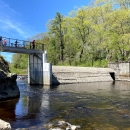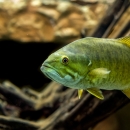Chautauqua Creek has high quality spawning habitat for several native Great Lakes fish, including white sucker, smallmouth bass and naturalized steelhead. Three fish barriers hampered upstream fish passage fish passage
Fish passage is the ability of fish or other aquatic species to move freely throughout their life to find food, reproduce, and complete their natural migration cycles. Millions of barriers to fish passage across the country are fragmenting habitat and leading to species declines. The U.S. Fish and Wildlife Service's National Fish Passage Program is working to reconnect watersheds to benefit both wildlife and people.
Learn more about fish passage . The lowermost passage barrier was a perched railroad bridge crossing; the middle barrier was the remnant of a former water control dam; and the uppermost barrier is a diversion dam that supplies water to the Village of Westfield, NY. The objective of this project was to utilize in-stream rock ramp construction to allow fish upstream passage over the three barriers. Boulders will be pinned at each location to ensure that the project does not fail during high flows. A v-notch weir was cut in the middle passage barrier. Grooves for stop logs were added as a control measure for sea lamprey. Partners included Chautauqua County Soil and Water Conservation District, Chautauqua County Department of Public Facilities, New York State Department of Environmental Conservation, Village of Westfield, Western New York Trout Unlimited and Great Lakes Basin Fish Habitat Partnership.
Habitat restoration, Population enhancement







